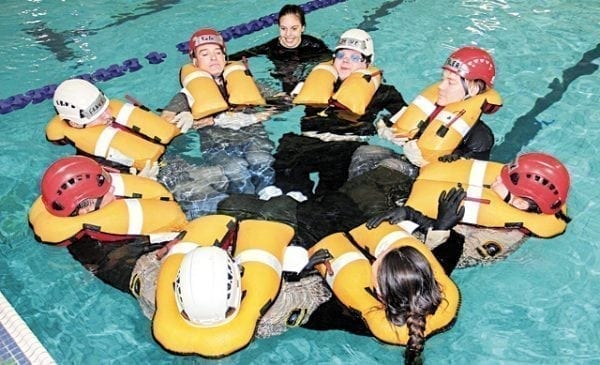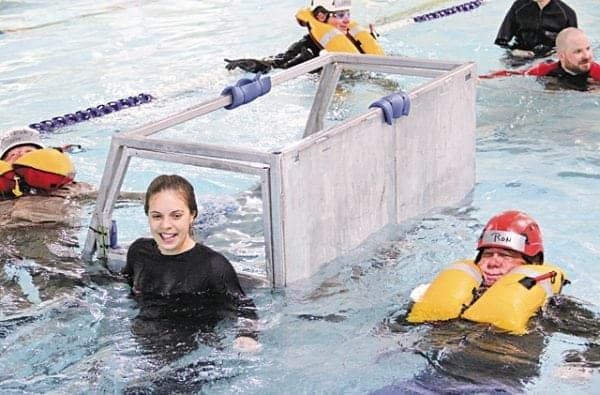Fifteen public servants should feel a bit more confident taking to the air – either in helicopters or small aircraft – as is sometimes required by their jobs.

Julie Downes, top centre, a field instructor with Arctic Response Canada Ltd. of Yellowknife, leads a group of employees from the Department of Environment and Natural Resources in an underwater egress training course at the Hay River swimming pool on Nov. 21. They had formed a circle in what's called the group heat escape lessening position.
That's because the workers with the Department of Environment and Natural Resources completed a one-day aircraft underwater egress training course on Nov. 21 at the swimming pool in Hay River.
The course was delivered by Julie Downes, a field instructor with Arctic Response Canada Ltd. in Yellowknife.
"You can really see an improvement with each student as they go through our different exercises, and often we'll have people who are starting off very nervous and afraid and eventually throughout that time in the pool they're learning how to stay calm, how to keep their brain calm in an adverse environment – an environment without any oxygen, which is hard for a lot of people," she said.
Downes often gets feedback from course participants that they were very nervous to do the training, but were feeling more confident afterwards about flying in the North because they know that they have the skills necessary to keep calm and get out of an aircraft that is in the water.
One of the students last week was Frank McKay, an aboriginal liaison officer with ENR.
"It's nice to do that type of specialized training because it gives experience to respond to a real-life situation," he said, noting he became calmer with being underwater and better able to respond as the training progressed.
McKay said the training gives him a little bit more confidence that in case anything happened in a chopper or an aircraft that he'd maybe have a better chance of surviving.
Downes said the training begins with several hours in class on subjects like underwater immersion, the effects of cold water on a human and surviving the post-accident environment.
Afterwards, it is off to the pool for several exercises on fixed-wing and rotary-wing aircraft simulators.
One simulator seats two students with a four-point harness that's very common in helicopters or rotary wing aircraft.

Julie Downes, left, a field instructor with Arctic Response Canada Ltd. of Yellowknife, guides employees of the Department of Environment and Natural Resources – including Ron D. Antoine, right – through an aircraft underwater egress training course.
"The goal with that simulator is to simulate how the aircraft reacts when it makes contact with the water," said Downes. "Since with a helicopter most of the weight is on top with the motor and the rotor up there, it tends to flip upside down and go sideways. So that's the motion that we're recreating with that."
The fixed-wing aircraft simulator also places course participants upside down in the water.
"Since most of the weight again is with the motor at the front of a smaller aircraft, they tend to pitch forward," said Downes. "So we're recreating that motion with a lap belt type seatbelt which we see in most airplanes."
This was the first time that Arctic Response Canada Ltd. simulators for underwater egress were used at the pool in Hay River.
"That's one that we don't travel a lot with," said Downes. "Usually we have folks coming in from out of town to take the course in Yellowknife."
However, the company got a request to take the simulators to Hay River and Fort Smith.
"I don't think we've had any egress training here before," said Ashley Coombs, the aquatics supervisor in Hay River. "Not that I am aware."
Coombs said the Hay River pool easily accommodated the simulators from Arctic Response Canada Ltd.
"They said that the setup of our facility made it very easy for them to get their equipment in and into the pool without having to use any lifts or anything," she said. "It was very accessible. It was one of the easiest egress trainings for them is what they had mentioned. So I was happy to hear that. We were happy to accommodate them."
Coombs said it was great to see the pool being utilized for a different type of training.
The training was organized by Glenn Bourke, the safety and training co-ordinator with ENR in Fort Smith.
Bourke noted that ENR had 55 employees take the training since Nov. 1 in Yellowknife, Inuvik, Hay River and Fort Smith.
Of the 15 trained in Hay River, about half came from Fort Simpson, Norman Wells and Fort Smith.
Bourke said the 15 were specially selected.
"If they have the possibility of flying in either a fixed-wing aircraft or a rotary aircraft, so either bush planes or helicopters," he explained. "They were chosen by their supervisors according to if there's a possibility that they will."
Bourke said safety is the department's first priority.